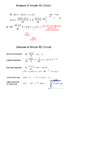drk15
Newbie level 3
Hello,
Can anybody explain me the capacitor charge/discharge equation derivation in detail?
Places I check, they start at either complicated point or in other easier version, some of the steps are omitted.
Any pointers/ links will be helpful too.
Thanks.
Can anybody explain me the capacitor charge/discharge equation derivation in detail?
Places I check, they start at either complicated point or in other easier version, some of the steps are omitted.
Any pointers/ links will be helpful too.
Thanks.
